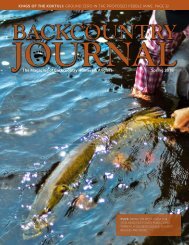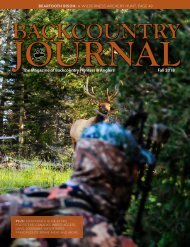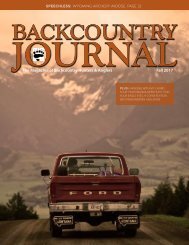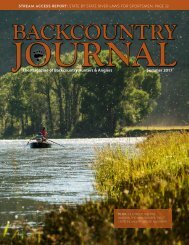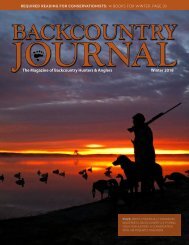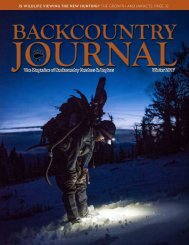BCJ_SPRING 17 Digital Edition
Create successful ePaper yourself
Turn your PDF publications into a flip-book with our unique Google optimized e-Paper software.
Michael Furtman photo<br />
PUBLIC LAND OWNER<br />
KINGDOM HERITAGE LANDS, VERMONT<br />
BY MATT BRETON<br />
I CUT THE BUCK’S TRACK BEFORE DAYLIGHT where he<br />
crossed the road off the snow-covered mountains to the west. It<br />
was the second to last day of the Vermont muzzleloader deer season,<br />
and the sand was rapidly sliding out of my hourglass. Following<br />
his track at sunup, I worked on sorting out his nighttime<br />
wanderings through private timberland, trying to stay warm on a<br />
cold December morning.<br />
The Kingdom Heritage Lands, tucked away in the northeast<br />
corner of Vermont, are a patchwork of private and government<br />
properties open to public hunting. Public access to these acres is<br />
protected through the collaboration of the U.S. Fish and Wildlife<br />
Service, the State of Vermont as well as nonprofit and private<br />
interests that demonstrate the value of conservation partnerships.<br />
The habitat is an extensive area of northern lowland forest and<br />
wetlands, ringed by hills and mountains of moderate elevation,<br />
drained by numerous streams flowing into the Connecticut River.<br />
Primarily boreal forest intermixed with hardwood, these lands<br />
support activities ranging from recreation-based tourism to wood<br />
harvest and maple sugaring. This forest region provides important<br />
habitat for numerous animal species on the edge of their ranges<br />
such as moose and spruce grouse. For New England sportsmen,<br />
the ability to hunt and fish timber company land borders on sacred.<br />
With 70 million people within a day’s drive, the existence<br />
of areas like this is uniquely important in satisfying the need to<br />
venture into remote stretches of wild country to track a whitetail<br />
buck or to land a brook trout that never before has risen to a<br />
fisherman’s fly.<br />
With the rut behind him, this buck was focused on recovering.<br />
His antlers left an impression in the snow on an old stump<br />
where he’d fed on mushrooms. Inadvertently I jumped him out<br />
of his morning bed, and the chase was on. The bucks of these<br />
big woods are wanderers by nature and typically cover miles of<br />
territory to feed, breed and finally head to their wintering areas.<br />
I followed him across several ridges heading steadily back uphill,<br />
noting where he stopped to check the wind. As the time and miles<br />
passed, I wondered if I’d get a chance to put my tag in his ear.<br />
In 1997, timber company Champion International decided to<br />
sell 132,000 acres in northeastern Vermont. This land had been<br />
managed for decades to produce an array of forest products with<br />
an emphasis on spruce-fir pulp wood for paper. The Conservation<br />
Fund of Arlington, Virginia purchased the ground in 1998 and<br />
a number of interested parties came together to protect and preserve<br />
this rich, multi-use area. TCF worked in partnership with<br />
the Vermont Land Trust, Vermont Agency of Natural Resources,<br />
Vermont Housing and Conservation Board, Vermont Chapter of<br />
The Nature Conservancy and USFWS to create a new model for<br />
the protection and management of large acreages in the northeast.<br />
This partnership is particularly special because of the focus<br />
on complementary management across the ownerships to achieve<br />
three equally important goals: working forests, ecological protection<br />
and public access.<br />
Doug Morin, a wildlife biologist/state land planner for the Vermont<br />
Department of Fish & Wildlife, called this arrangement<br />
“unique for Vermont and rare for New England.” He also said,<br />
“It might be a model for future public-private partnerships for<br />
industrial timberland.”<br />
The region’s people had a voice in shaping the direction of the<br />
Kingdom Heritage Lands with 35 public meetings, workshops<br />
and comment sessions – a level of input without precedent in Vermont.<br />
The management plan divided ecologically significant areas<br />
into federal land as part of the Silvio O. Conte National Wildlife<br />
Refuge and state land in the West Mountain Wildlife Management<br />
Area. The remaining acreage was purchased by Essex Timber<br />
Company, later sold to current owner Plum Creek Timber<br />
Company, for working forestry with easements protecting certain<br />
natural resources and guaranteeing perpetual public access.<br />
After several miles, the buck finally fed again and I knew he<br />
soon would lie down. Slowing my pace, I began to search the<br />
timber for his bedded form. I eased through one opening and<br />
then into another with slow, quiet steps. Then I spotted him only<br />
40 yards away. He slowly turned his head, revealing his antlers<br />
and confirming what his tracks had told me several hours earlier.<br />
The hanging black powder smoke slowly cleared. With the<br />
tracking job now complete, I set myself to the reverent tasks of<br />
dragging the deer out and getting him into my freezer.<br />
The Northeast is not known for its public hunting opportunities.<br />
As the timber industry changes, this unique collaboration<br />
of public, private and nonprofit partners has been a successful<br />
means to preserve and protect our wild places and traditions. I’ve<br />
hunted the Rocky Mountain West and I am thankful for the vast<br />
expanses available there, but being able to track a buck in classic<br />
New England fashion leaves me with a sense of accomplishment<br />
rooted in tradition. I am lucky to have a home landscape as rich<br />
and accessible as our Kingdom Heritage Lands.<br />
Matt is a native Vermonter who joined BHA after it dawned on<br />
him just how important public lands are, following a trip to Colorado<br />
to hunt elk. He helps produce the New England chapter e-newsletter.<br />
12 | BACKCOUNTRY JOURNAL FALL 2016<br />
<strong>SPRING</strong> 20<strong>17</strong> BACKCOUNTRY JOURNAL | 13




